Toilet bowl plunger - types and uses
Sewage clogging is a fairly common and very unpleasant phenomenon. However, in most cases it is possible to eliminate this malfunction of the sewage system on its own, for this you only need a plunger. Actually, this article is devoted to this adaptation, in which we will get acquainted with its structure, types and consider the sequence of work with the delivered instrument.
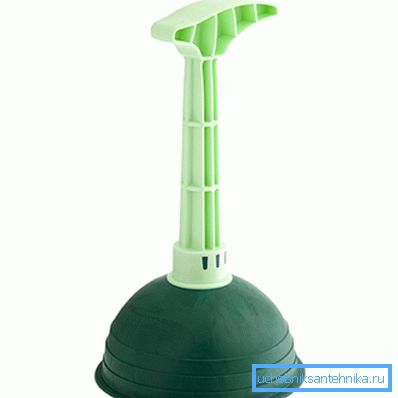
General information
Plunger is a device designed to mechanically eliminate blockages in the sewage system. The principle of operation is based on the destruction of the plug created by pressure and discharge in the system.
It should be noted that the use of this device is the most gentle method of cleaning, which excludes the use of caustic chemicals and mechanical damage to the walls of the pipeline. Due to this, as well as ease of use, this device is very popular and is available in almost every apartment.
It should be noted that the plunger is most effective in cases when the blockage occurred close to the hole of the toilet bowl or other plumbing.
Tip! The efficiency of using a plunger is increased when used in conjunction with chemicals. True, the latter should be used carefully, making sure that they are suitable for your type of installed sewer pipes.
Types of plungers
Today, there are two types of plungers:
- Mechanical;
- Pneumatic.
Combines both devices only the name and principle of impact on the cork. Therefore, below we consider each type of this device separately.
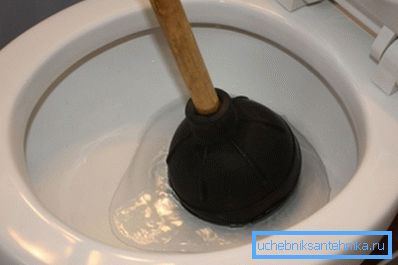
Mechanical
The design of the mechanical plunger is extremely simple and includes only two parts:
- Rubber bulb;
- A wooden or plastic handle that attaches to the pear.
Instructions for using this device is extremely simple:
- First of all, you need to plug the drain and overflow holes of plumbing, which is located nearby (bathroom, sink, etc.).
- Then a small amount of water is poured into a toilet or other plumbing fixture that needs to be cleaned so that the fluid level completely covers the drain hole.
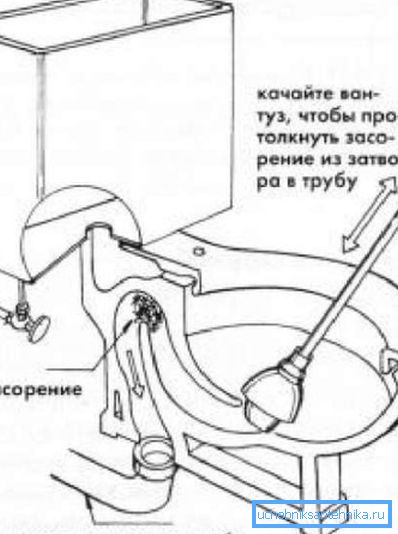
- After that, the device is placed so that the pear completely covers the drain hole, respectively, it must be of a sufficiently large diameter.
- Next, you need to perform several active strokes, after which the device can be removed.
- If the water in the toilet is not gone, the procedure should be repeated.
- After the cork is destroyed and the water goes down the drain, pour a boiling water pot into the drain hole (if the plumbing fixture is connected with a plastic corrugation, then hot water should be poured, but not boiling water).
Here, in fact, the whole process of cleaning.
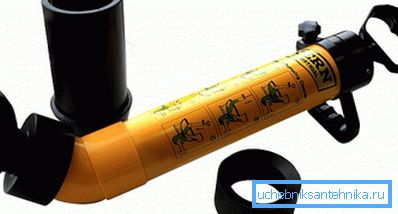
Pneumatic
Pneumatic plunger is a much more efficient device, and belongs to the category of professional equipment. However, despite this, even an amateur can use it with his own hands.
In fact, the design is a pump with a rubber tip, ensuring a snug fit of the pump nozzle to the plumbing surface. Pump capacity is usually one to two liters.
I must say that the pneumatic plunger for toilet bowls and bathtubs can have a different design. The differences are mainly in the diameter and shape of the tip, as well as the shape of the handle. For example, some models are equipped with a wide suction cup, which allows you to clean the shower cabin drain, while others are simply equipped with a rubber ring.
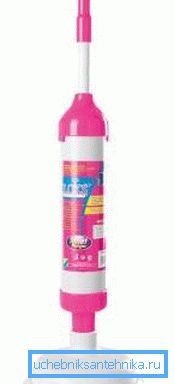
Note! The most versatile option are models with interchangeable nozzles. This allows you to use the device to clean the most different plumbing. Of course, the price of such models is higher.
Using a pneumatic device is not more difficult than mechanical.
This is done as follows:
- First of all, you need to get water in the tank. Next, you need to lower the pump nozzle into the water and gently lift the handle to get some water.
- As with conventional plunger, it is advisable to plug the plumbing and overflow of nearby plumbing.
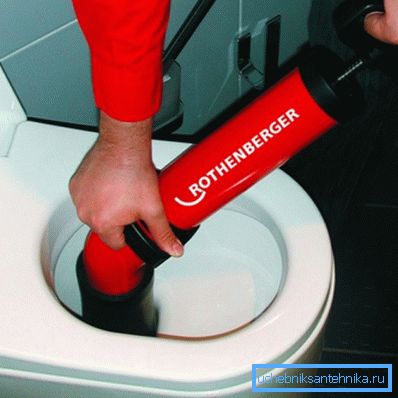
- Next, you need to forcefully press the rubber nozzle to the drain hole, so that it is completely closed. If necessary, the edges of the nozzle need to straighten.
- Then the piston should be sharply forced into the plunger tank. At the same time there will be a strong flow of water, which will destroy the blockage and wash away into the sewer.
- If you did not succeed in removing the cork from the first time, the procedure should be repeated several more times. As a rule, even strong blockages are washed after several such procedures.
- At the end of the work, as in the previous case, the plumbing should be washed with boiling water.
At this process, cleaning the toilet is completed.
Conclusion
The plunger is a simple and sufficiently effective device for removing blockages in toilet bowls and other plumbing, especially with regard to pneumatic devices. Of course, there are cases when it is impossible to do without qualified assistance of specialists. However, with most blockages, these devices are still able to cope.
From the video in this article you can learn more about this topic.